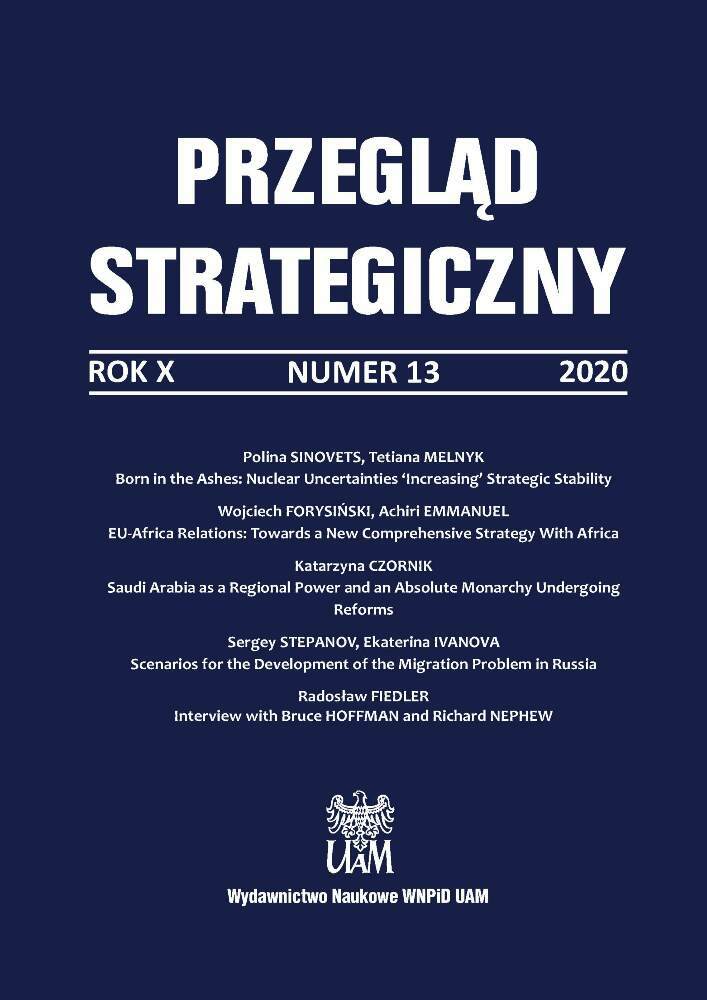Abstract
This article aims to analyse prevalent narratives on China’s rise among American academia. The attribution of a scholar to a given narrative depends on how their ideas and arguments resonate with three pivotal questions: 1) what is the current balance of power between the US and China?; 2) which variables and determinants have the greatest impact on the trajectory of Sino-American relations?; 3) what are the prospects of China’s rise?. The author identifies three core narratives: 1) pessimistic which acknowledges deteriorating position of the West and anticipation of a conflictual character of future relations between China and the US; 2) a balanced view that recognizes a relative decline of the US, but also assumes that China’s re-emergence has apparent limitations. Potential hegemonic war is both probable and avoidable either through deeper engagement or different forms of balancing; 3) an optimistic narrative which stresses internal and external barriers to China’s development that preclude its potential rise to global leadership or the preponderance of American power which is likely to endure in coming decades. The Author adopts constructivist approach and employs methods of critical discourse analysis and categorization.
Funding
The research leading to these results has received funding from the project titled “Poland in the contemporary geopolitical and geostrategic conceptions” funded by the Ministry of National Defense of Poland and included in the War Studies Academy financial plan for 2017 nr 306 (project code III 1.7.0).
References
Acharya A. (2014), The End of American World Order, Polity Press, Cambridge.
Allison G. (2017), Destined for war: can America and China escape Thucydides trap?, Scribe, London–Melbourne.
Art R. J. (2010), The United States and the Rise of China: Implications for the Long Haul, “The Journal of Public and International Affairs”, Vol. 125, No. 3, pp. 359–391.
Brooks S. G., Wohlforth W. C. (2016), The Rise and Fall of the Great Powers in the Twenty-first Century: China’s Rise and the Fate of America’s Global Position, “International Security”, Vol. 40, No. 3, pp. 7–53.
Christensen T. J. (2015), The China challenge: shaping the choices of a rising power, Norton, New York.
Department of Defense (2019), Indo-Pacific Strategy Report: Preparedness, Partnerships, and Promoting a Networked Region.
Friedberg A. (2011), A contest for supremacy: China, America, and the struggle for mastery in Asia, W.W. Norton, New York–London.
Friedberg A. (2015), The Debate Over US China Strategy, “Survival”, Vol. 57, No. 3, pp. 89–110, DOI: 10.1080/00396338.2015.1046227.
Gaddis J. L. (1993), International Relations Theory and the End of the Cold War, “International Security”, Vol. 17, No. 3, pp. 5–58.
Glaser C. (1997), The Security Dilemma Revisited, “World Politics”, Vol. 50, No. 1, pp. 171–201.
Glaser C. (2011), Will China’s Rise Lead to War? Why Realism Does Not Mean Pessimism, “Foreign Affairs”, Vol. 90, No. 2, pp. 80–91.
Glaser J. (2018), Status, Prestige, Activism and the Illusion of American Decline, “The Washington Quarterly”, Vol. 41, No. 1, pp. 173–197, DOI: 10.1080/0163660X.2018.1445903.
Ikenberry J. G. (2008), The Rise of China and the Future of the West. Can the liberal system survive?, “Foreign Affairs”, Vol. 87, No. 1, pp. 23–37.
Kennedy P. (1989), The rise and fall of the great powers: economic change and military conflict from 1500 to 2000, Random House, New York.
Kindleberger C. (1986), The World in Depression 1929–1939, University of California Press, Berkeley.
Kupchan C. A. (2012), No one’s world: the West, the rising rest, and the coming global turn, Oxford University Press, Oxford.
Lebow R. N. (1994), The Long Peace, the End of the Cold War, and the Failure of Realism, “International Organization”, Vol. 48, No. 2, pp. 249–277.
Lyle J. Goldstein (2015), Meeting China halfway: how to defuse the emerging US-China rivalry, Georgetown University Press, Washington.
Martel W. C. (2015), Grand Strategy in Theory and Practice, Cambridge University Press, New York.
Mearsheimer J. J. (2014), The Tragedy of Great Power Politics, W. W. Norton, New York–London.
Nye J. S. (2011), The future of power, Public Affairs, New York.
Nye J. S. (2015), Is the American Century Over?, Polity, Cambridge–Malden.
Shambaugh D. (2005), The new strategic triangle: U.S. and European reactions to China’s rise, “The Washington Quarterly”, Vol. 28 No. 3, pp. 5–25, DOI: 10.1162/0163660054026470.
Shambaugh D. L. (2013), China goes global: the partial power, Oxford University Press, Oxford.
Shambaugh D. L. (2016), China’s future, Polity Press, Cambridge.
The White House (1990), National Security Strategy of the United States.
Vogel Ezra (1979), Japan as Number One: Lessons for America, Harper&Row, New York.
Walt S. W. (1985), Alliance Formation and the Balance of World Power, “International Security”, Vol. 9, No. 4 (Spring), pp. 3–43.
Walt S. W. (1990), The Origins of Alliances, Cornell University Press, Ithaca–London.
Weede E. (2010), The Capitalist Peace and the Rise of China: Establishing Global Harmony by Economic Interdependence, 36: 2, 206–213, DOI: 10.1080/0305062100378518.
Zakaria F. (2008), The post-American world, W. W. Norton & Company, New York–London.

